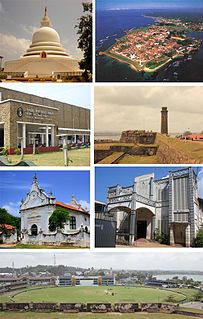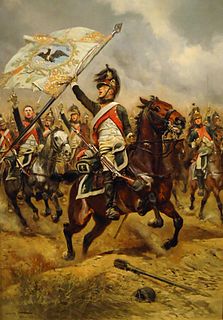
Dragoons originally were a class of mounted infantry, who used horses for mobility, but dismounted to fight on foot. From the early 18th century onward, dragoons were increasingly employed as conventional light or medium cavalry, or in the British army also heavy cavalry, trained for combat with swords from horseback.

A regiment is a military unit. Their role and size varies markedly, depending on the country and the arm of service.

Chasseur, a French term for "hunter", is the designation given to certain regiments of French and Belgian light infantry (chasseurs à pied) or light cavalry (chasseurs à cheval) to denote troops trained for rapid action.

Light infantry is a designation applied to certain types of foot soldiers (infantry) throughout history, typically having lighter equipment or armament or a more mobile or fluid function than other types of infantry, such as heavy infantry or line infantry. Historically, light infantry often fought as scouts, raiders and skirmishers—soldiers who fight in a loose formation ahead of the main army to harass, delay, disrupt supply lines, and generally "soften up" an enemy before the main battle. After World War II, the term "light infantry" evolved, and now generally refers to rapid-deployment units that specifically emphasize speed and mobility over armor and firepower. Some units or battalions that historically held a skirmishing role have kept their designation "light infantry" for the sake of tradition.

The Bangladesh Infantry Regiment is an infantry regiment of the Bangladesh Army. It was raised in 2001 as the second combat regiment after the East Bengal Regiment. The regiment was raised initially by transferring units of the East Bengal Regiment to the new Bangladesh Infantry Regiment centre, before its own recruits were trained. This regiment was the first new unit raised by Bangladesh Army in the 21st Century, and consequently is also known as the Regiment of the Millennium.

The Parachute Regiment is an airborne infantry and special forces regiment of the Indian Army.
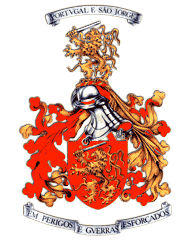
The Portuguese Army is the land component of the Armed Forces of Portugal and is also its largest branch. It is charged with the defence of Portugal, in co-operation with other branches of the Armed Forces. It is one of the oldest armies in the world, with its origins going back to the 12th century.
Colonel (Col) is a rank of the British Army and Royal Marines, ranking below brigadier, and above lieutenant colonel. British colonels are not usually field commanders; typically they serve as staff officers between field commands at battalion and brigade level. The insignia is two diamond-shaped pips below a crown. The crown has varied in the past with different monarchs; the current Queen's reign has used St Edward's Crown. The rank is equivalent to captain in the Royal Navy and group captain in the Royal Air Force.

The South African Irish Regiment is an infantry regiment of the South African Army. As a reserve unit, it has a status roughly equivalent to that of a British Army Reserve or United States Army National Guard unit.

The Pretoria Highlanders Regiment was a regiment of the South African Army. As a reserve unit, it had a status roughly equivalent to that of a British Army Reserve or United States Army National Guard unit.

Regiment Boland was an infantry regiment of the South African Army. As a reserve unit, it had a status roughly equivalent to that of a British Territorial Army or United States Army National Guard unit.
There are 13 Cavalry Regiments of the British Army each with its own unique cap badge, regimental traditions, and history. Of the currently 9 regular cavalry regiments; 2 serve as armoured regiments, 3 as armoured cavalry regiments, 3 as light cavalry and 1 as a mounted ceremonial regiment. There are also four yeomanry regiments of the Army Reserve, of these, 3 serve as light cavalry and 1 as an armoured regiment. Each yeomanry light cavalry unit has been paired with a regular unit of the same role, the armoured yeomanry unit is paired with the 2 regular armoured units. All except the Household Cavalry are part of the British Army's Royal Armoured Corps.
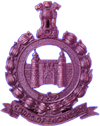
The Corps of Engineers of the Indian Army has a long history dating back to the mid-18th century. The earliest existing subunit of the Corps dates back to 1777 while the Corps officially recognises its birth as 1780 when the senior most group of the Corps, the Madras Sappers were raised.

The regiments of Bengal Native Infantry, alongside the regiments of Bengal European Infantry, were the regular infantry components of the East India Company's Bengal Army from the raising of the first Native battalion in 1757 to the passing into law of the Government of India Act 1858. At this latter point control of the East India Company's Bengal Presidency passed to the British Government. The first locally recruited battalion was raised by the East India Company in 1757 and by the start of 1857 there were 74 regiments of Bengal Native Infantry in the Bengal Army. Following the Mutiny the Presidency armies came under the direct control of the United Kingdom Government and there was a widespread reorganisation of the Bengal Army that saw the Bengal Native Infantry regiments reduced to 45.

The Hampshire Yeomanry was a yeomanry cavalry regiment formed by amalgamating older units raised between 1794 and 1803 during the French Revolutionary Wars. It served in a mounted role in the Second Boer War and World War I, and in the air defence role during and after World War II. The lineage is continued by 295 Battery and 457 Battery, batteries of 106 (Yeomanry) Regiment Royal Artillery, part of the Army Reserve.
United States Volunteers also known as U.S. Volunteers, U. S. Vol., or U.S.V. were military volunteers enlisted in the United States Army who were separate from the Regular Army.
The 101st Regiment of Foot was a regiment in the British Army raised in 1805 and disbanded in 1817. It was the last unit in the British Army to be raised through a contract with an individual.

Regiment Molopo was an armoured regiment of the South African Army. As a reserve unit, it had a status roughly equivalent to that of a British Army Reserve or United States Army National Guard unit.
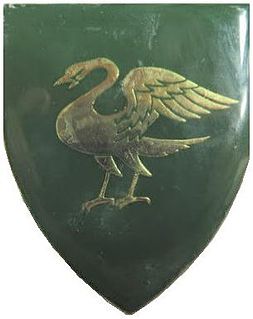
Regiment Springs was an infantry battalion of the South African Army. As a reserve force unit, it had a status roughly equivalent to that of a British Army Reserve or United States Army National Guard unit.
